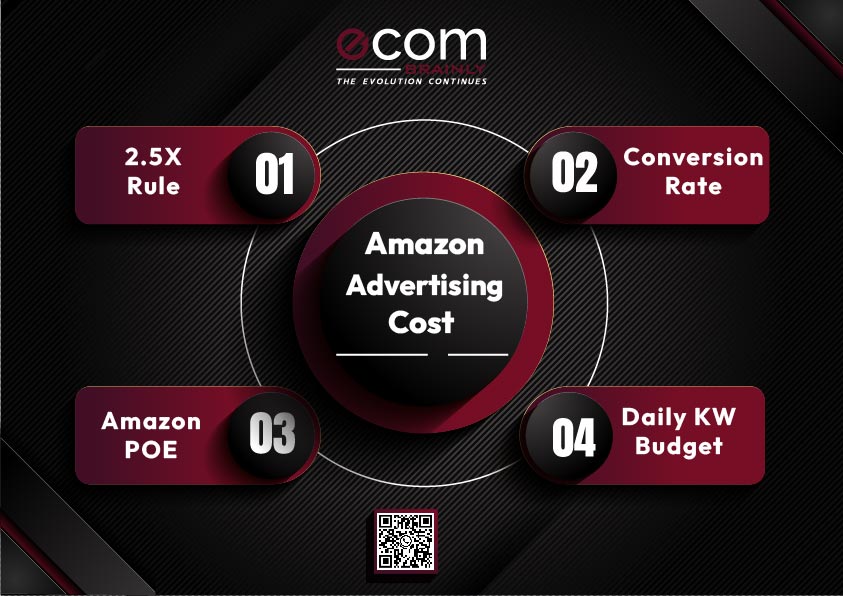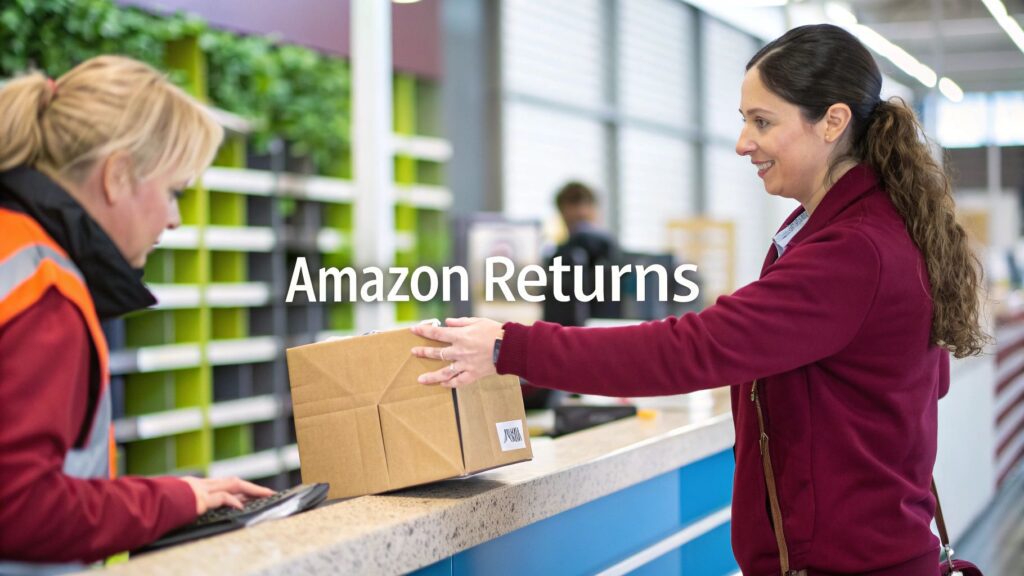Amazon PPC (Pay-Per-Click) advertising has become an important tool for sellers to improve product rankings and boost sales. However, the Amazon PPC cost of running these campaigns has been steadily rising, making it important for sellers to factor these expenses into their overall business strategy.
Many sellers overlook the importance of calculating Amazon advertising cost when finalizing their product. They often consider the Amazon FBA fees, product costs, and shipping expenses but fail to account for the significant impact of pay-per-click expenses on their net profit.
By not including these costs in their calculations, sellers might end up with a lower net profit margin than anticipated.
To better estimate the net profit, it’s essential to consider all expenses, including advertising costs.
This approach helps sellers avoid surprises and plan their budgets more effectively, ensuring that their business remains profitable even as costs increase.
The 2.5x Rule of Amazon PPC Cost
One useful guideline is the 2.5x rule, which suggests that your target Amazon PPC cost should be approximately 2.5% of your product’s selling price. For example, if your product sells for $20, your target cost per click (CPC) should ideally be no more than $0.50 ($20 x 2.5%).
Let’s break this down further with a practical example:
Product Price: $20
Target CPC: $0.50 (2.5% of $20)
Conversion Rate: 10% (typical for many products)
Daily Target Orders: 30
To achieve 30 orders with a 10% conversion rate, you would need 300 clicks (since 10% of 300 clicks results in 30 orders).
Calculations:
Number of Clicks Required: 30 orders / 10% conversion rate = 300 clicks
Total PPC Cost: 300 clicks x $0.50 CPC = $150.
Therefore, to achieve 30 daily orders, you would need to budget $150 per day for your PPC campaigns based on the 2.5x rule.
However, it’s important not to rely solely on this rule. Proper data analysis and accurate calculations, which will be discussed in this article, are essential for managing your Amazon advertising cost effectively.
Factors Influencing Amazon PPC Costs
Knowing how Amazon PPC cost per click (CPC) is determined is essential if you want to control your ad spend and scale profitably. Amazon PPC pricing isn’t random it’s a result of how your bid, product relevance, competition, and conversion performance interact within Amazon’s A10 algorithm.
The average Amazon PPC cost can vary widely by category. For Sponsored Product Ads, CPC often ranges from $0.40 to $1.20, while Sponsored Brands Ads can go higher depending on competition and keyword type. Knowing these factors helps you plan your Amazon PPC budget more accurately and prevent wasted ad spend.
1. Competition
Competition is one of the biggest drivers of Amazon advertising cost. Each keyword triggers a real-time auction where sellers compete for visibility. The higher the competition, the higher the cost per click (CPC) you’ll pay.
For example, if five sellers are targeting “wireless earbuds,” CPC can easily exceed $1.50 due to category saturation. On the other hand, a niche long-tail keyword like “wireless earbuds for workouts” may cost around $0.60 per click due to lower number of sellers bidding on it and also converts better.
This shows why Amazon long-tail keywords are essential for PPC optimization and they reduce competition, lower CPC, and often bring higher-intent traffic.
2. Click-Through Rate (CTR)
CTR directly affects your Amazon PPC campaign cost because it signals how relevant your ad is to shoppers.
Formula: CTR = (Clicks ÷ Impressions) × 100
Higher CTR tells Amazon that your ad matches buyer intent, which improves your ad’s Quality Score and can reduce CPC. If your CTR jumps from 2% to 4%, you might see your average cost per click drop by 10–15%.
You can improve CTR by testing main images, titles, pricing, and review count — especially for Sponsored Product Ads at the top of search placements.
3. Conversion Rate (CVR)
Conversion rate directly influences both Amazon PPC pricing and profitability.
Formula: CVR = (Orders ÷ Clicks) × 100
If 100 clicks generate 5 orders (5% CVR), you’re spending more per sale compared to 10% CVR. Higher conversion signals listing relevance, helping you maintain strong ad placement at lower CPC.
To improve CVR, focus on conversion rate optimization through better listing design, pricing strategy, and keyword alignment, especially on mobile, where most Sponsored Product traffic originates.
4. Bidding Strategies
Amazon offers multiple PPC bidding strategies that influence your cost:
- Dynamic Bids – Down Only: Reduces bids when your ad is less likely to convert.
- Dynamic Bids – Up & Down: Raises or lowers bids based on conversion likelihood.
- Fixed Bids: Keeps bids constant regardless of performance.
- Rule-Based Bidding: Allows automation with “if/then” logic, ideal for experienced advertisers.
For example, with a base bid of $1.00 using Up & Down, Amazon may push your bid to $1.80–$2.00 for top-of-search positions if conversion likelihood is high.
Choosing the right bidding method can prevent overspending. For example, Dynamic Up & Down works best for competitive placements like Top of Search, while Fixed Bids suit testing campaigns or niche keywords.
5. Product Relevance and Quality Score
Product relevance defines how closely your product matches the shopper’s search keyword. Amazon’s algorithm uses keyword relevance, CTR, and CVR to determine how your listing ranks in the ad auction.
Optimizing your Amazon backend keywords for PPC and product titles with exact match terms increases your Quality Score, reducing CPC.
6. Bid Amount and Ad Rank
Your Amazon PPC keyword cost depends on your bid and quality score interaction.
Ad Rank = Bid × Quality Score
Even if you bid lower, a high-quality listing can win. Example:
Seller A: Bid $1.25 × Quality 7 = 8.75
Seller B: Bid $1.00 × Quality 9 = 9 → Wins cheaper CPC.
This is why product optimization and keyword targeting are as crucial as your bid itself.
7. Ad Placement Multipliers
Ad placement affects how Amazon calculates your Sponsored Product Ads cost.
- Top of Search (TOS): Most expensive, highest conversion rate.
- Product Pages (PP): Moderate CPC, ideal for competitor targeting.
- Rest of Search (ROS): Lowest CPC, less traffic but often profitable.
If your base bid is $1 and your Top of Search multiplier is +50%, Amazon can bid $1.50 for that spot. Analyzing placement reports shows which segment drives the best ROAS before adjusting multipliers.
3.8. Customer Search Term Performance
Your Amazon PPC campaign cost often depends on how well specific search terms perform. Some drive sales, others waste budget.
Regularly analyze the Search Term Report to identify:
- Profitable terms → Increase bids 10–20%.
- Poor-performing terms → Add as negative keywords.
This is a key part of ongoing Amazon PPC optimization.
3.9. Seasonality and Market Trends
Seasonality impacts overall Amazon advertising cost. During events like Prime Day, Cyber Monday, or Q4 holidays, CPCs may rise by 40–60%.
Example: in categories like Toys or Home Decor, CPC jumps from $0.60 to $1.00 due to high competition. Plan early by increasing budgets gradually and tracking how seasonal demand affects your keyword-level CVR.
3.11. Listing Quality and Offer Strength
Even with the best bidding strategies, your campaign won’t perform if your product offer is weak. Amazon favors listings with strong review history, competitive pricing, and reliable fulfillment.
If your product is FBA, priced well, and has over 20 reviews, it will naturally achieve higher conversion and lower CPC, improving your Amazon PPC optimization over time.
3.12. Historical Performance
Amazon rewards consistency. Campaigns with stable CTR, CVR, and ACoS get lower CPCs as the algorithm “trusts” them. Avoid pausing campaigns frequently, instead, lower bids gradually and let Amazon maintain your learning data for better PPC campaign management.
3.13. A10 Algorithm Influence
The Amazon search algorithm (A10) prioritizes relevance and buyer satisfaction. It doesn’t always favor the highest bidder — it favors the ad most likely to convert.
That’s why keyword targeting, product targeting, and category targeting all matter. Use tools like Helium10 or JungleScout for precise keyword research and track how engagement metrics (CTR, CVR) impact CPC.
3.14. Sponsored Brands and Display Ad Costs
The cost of Sponsored Brands Ads is typically higher than Sponsored Products because of broader visibility. Sponsored Display Ads can be cheaper per click but have lower conversion rates.
Sponsored Brands CPC averages between $0.70 and $1.40, while Sponsored Display often sits around $0.35–$0.80. Allocate your Amazon advertising budget strategically. Sponsored Products for direct sales and ranking, Sponsored Brands for brand awareness, and Display for retargeting.
3.15. Product and Category Targeting Costs
Amazon product targeting cost varies by how competitive the targeted ASIN is. High-traffic products can cost $1+ per click, while niche listings may cost $0.30–$0.50.
Amazon category targeting cost depends on category competitiveness. Targeting “Home Decor” may cost twice as much as “Desk Accessories.” Refine targets based on CTR and ACoS to maintain profitability.
4. Calculating Amazon PPC Costs – Step-by-Step Guide
When launching an Amazon PPC campaign, it’s crucial to carefully plan and calculate your budget to ensure you’re investing wisely. By following these steps, you can create a detailed and effective budget tailored to your specific needs.
4.1. Selecting High-Relevant Keywords
The first step in building an effective Amazon PPC cost strategy is selecting high-impact keywords that are highly relevant to your product. Use tools like Helium10 to find the most suitable keywords for your campaign. Create a list of the top 15 keywords you will target in your Amazon PPC campaigns.
For example, if you’re selling eco-friendly water bottles, your high-impact keywords might include “reusable water bottle,” “eco-friendly bottle,” and “BPA-free water bottle.”
4.2. Calculating Your Conversion Rate
Conversion rate is a critical metric that directly affects your Amazon advertising cost. It represents the percentage of customers who make a purchase after clicking on your ad.
Here’s the formula:
Conversion Rate = (Conversions / Clicks) * 100
Let’s break it down into two scenarios:
Scenario 1: Existing Products
If you’re already selling a product, there are several ways to calculate the conversion rate:
- Amazon Business Reports: Go to Business Reports from the Reports menu in Seller Central. Review your sales and traffic data, and look for the “Order Item Session Percentage” row, which represents your conversion rate.
- Brand Metrics: This tool offers insights into the top and median conversion rates for your category. If you’re launching a new product within an existing category, this is an excellent way to estimate your conversion rate. Access it by going to Seller Central’s campaign manager and selecting “Insights and Planning.”
Scenario 2: Entering a New Niche
If you’re entering a new niche, estimating the average conversion rate can be challenging but necessary for budget planning.
Product Opportunity Explorer (POE): Use this tool to analyze search terms and products data. To calculate the conversion rate:
- Navigate to the “Growth” tab in Seller Central and select “Product Opportunity Explore“.
- Search by Keyword or ASIN and select the relevant niche.
- Download the “Search Terms” and “Products” data as shown in image below.
- In the “Products” sheet, sum up the “Niche Click Count (Past 360 days)” of all the products appearing in the sheet.
- In the “Search Terms” sheet, find the “Click Share” and multiply it by “Total Niche Click Count (Past 360 days)” from the step 4 to find “Total Clicks” for a specific search term.
- In “Search Terms” you will see two columns I) “Search Conversion Rate (Past 360 days)” and, II) Search Volume (Past 360 days). Now multiply the values of these columns and you will get “Total Purchases” for a search term.
- Finally, use the formula: Conversion Rate = (Purchases / Clicks) * 100 to estimate the conversion rate for each search term, and then calculate an average conversion rate.
- For instance, if the total purchases are 500 and the total clicks are 5,000, the conversion rate would be: Conversion Rate = (500 / 5000) * 100 = 10%
This estimated conversion rate can then be used for your PPC cost estimates.
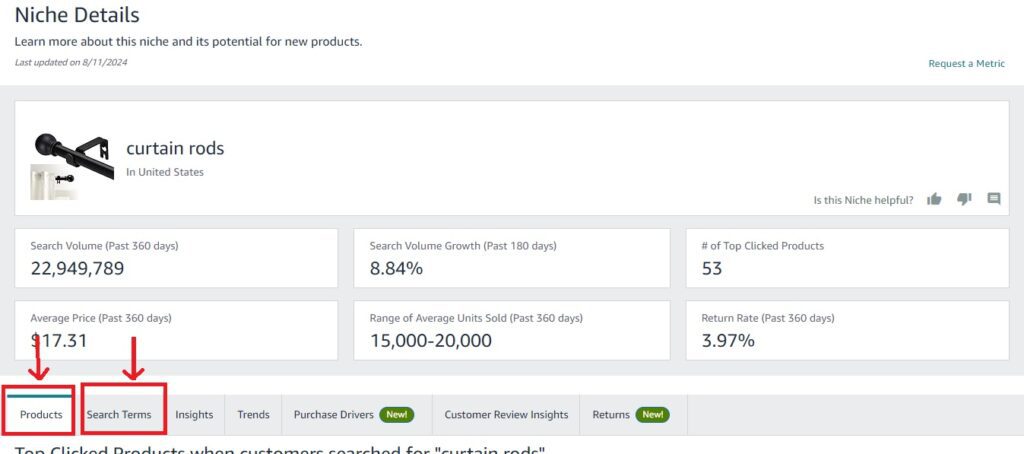
Product Opportunity Explorer Interface
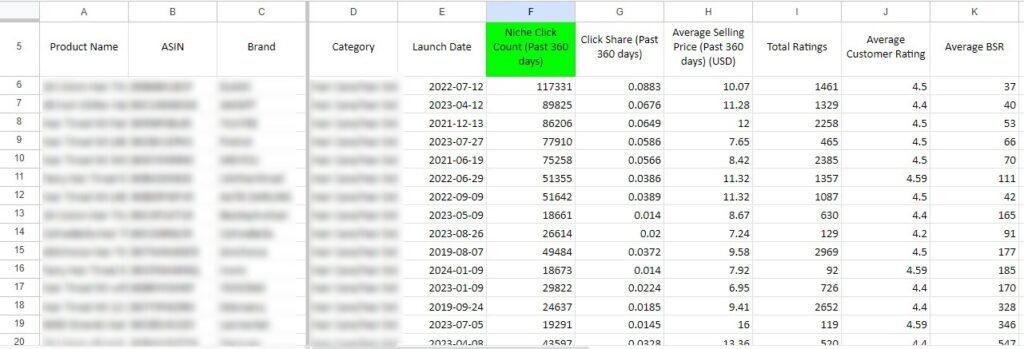
Products Data

Search Terms Data
4.3. Determining CPC for Your Keywords
Once you have your keywords and conversion rate, the next step is to determine the cost per click (CPC) for each keyword. You can use Helium10 Cerebro to reverse ASIN the top competitors and find the suggested bid range for your keywords.
For instance, if the suggested bid range for “reusable water bottle” is $0.80 to $1.20, you could use an average CPC of $1.00 for your calculations.
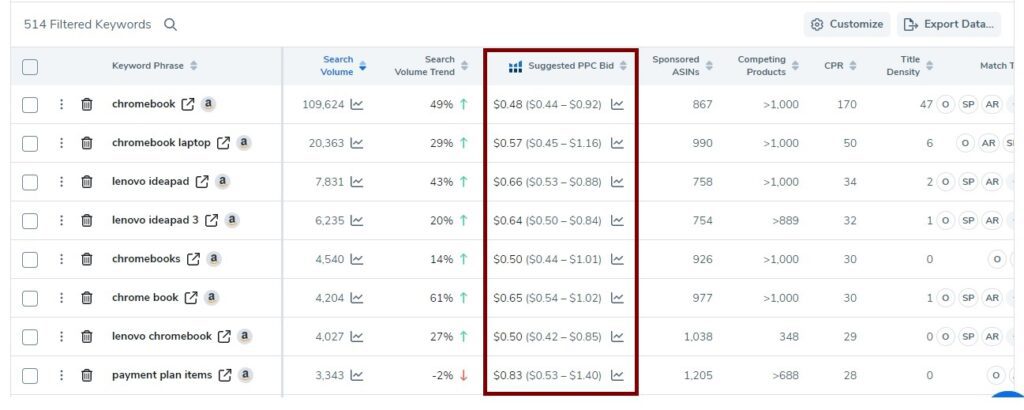
4.4 Projecting Daily Sales
Daily sales are the number of orders required to rank for a specific keyword. Helium10 provides a metric called “CPR 8-Days Orders,” which indicates the number of sales needed over eight days to start ranking for a keyword.
For example, if “reusable water bottle” has a CPR of 100, you need to generate 100 sales over eight days to rank. This breaks down to approximately 13 sales per day:
Daily Target Orders = CPR / 8 = 100 / 8 ≈ 13 orders per day
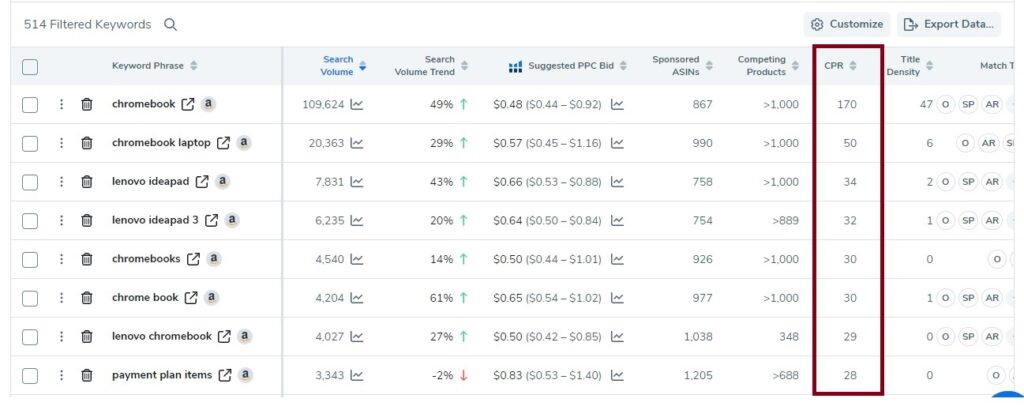
4.5 Estimating Daily Clicks
To estimate how many clicks you need to generate these 13 target orders, use the formula:
Daily Clicks Required = (1 / Conversion Rate) * Target Daily Orders
Using the earlier example with a 10% conversion rate:
Daily Clicks Required = (1 / 0.10) * 13 = 130 clicks per day
4.6 Calculate Daily Keyword Budget
With all this data in hand, you can now estimate the daily PPC cost for a specific keyword. Use the formula:
Daily Keyword Budget Required = Daily Orders * (1 / Conversion Rate) * CPC
Continuing with our example:
Daily Keyword Budget Required = 13 orders * (1 / 0.10) * $1.00 = $130/Day
This means you would need a daily budget of $130 to achieve 13 orders per day for the keyword “reusable water bottle.”
Now, apply this method to calculate the PPC costs for the top 15 keywords you selected. By summing these daily costs, you can estimate your total monthly budget required to rank for these keywords.
Keep in mind that these are estimates; actual costs may vary due to fluctuations in CPC, search volume, and competition.
5. Advanced Strategies to Reduce Advertising Cost
Reducing your Amazon PPC cost is not only slashing bids or turning off campaigns. It’s all about using data-backed strategies that maintain sales momentum while lowering wasted ad spend. Every dollar saved in inefficient clicks can be reallocated to profitable keywords or high-converting ASINs.
5.1 Conversion Rate Optimization (CRO)
Improving conversion rate directly reduces your cost per acquisition. Let’s say you’re spending $1.20 per click and your listing converts at 10%. You’ll need 10 clicks ($12) to get one sale. If you optimize your listing to convert at 20%, you now need only 5 clicks (saving $6) for one sale by cutting your Amazon advertising cost by half without touching bids.
Practical ways to improve CRO:
High-quality product images: Show lifestyle use. For example, if you sell a yoga mat, show it in a home gym setup
Keyword-rich titles: Include core and long-tail keywords naturally. Example: instead of “Yoga Mat – Non Slip,” use “Eco-Friendly Non Slip Yoga Mat for Home Workouts.”
Amazon A+ and Brand Story: Add infographics explaining material benefits, comparison charts, and usage instructions.
Product reviews and Vine program: Use Vine to build reviews for new listings. A product with 50+ reviews and 4.5-star average usually converts 3–4x better than one with under 10 reviews.
Higher conversion rate not only reduces your PPC spend but also improves Quality Score, which can lower your Amazon PPC cost per click over time.
5.2 Targeting Long-Tail Keywords
Long-tail keywords generally have 30–50% lower CPCs than broad ones. A seller targeting “water bottle” might pay $2.10 per click, but switching to “BPA-free sports water bottle” could cost around $1.20 with better conversion intent.
To find profitable long-tail terms, use keyword research tools like Helium10, JungleScout, or Amazon Search Term Report.
5.3 Smart Bidding Strategies
Bidding strategy controls how Amazon adjusts your bids in real time.
- Dynamic Bids – Down Only: Use this for mature products with steady sales.
- Fixed Bids: Ideal for manual control. Test fixed bids when you have accurate data on keyword performance.
- Rule-Based Bidding: Example rule — If ACOS > 40% and conversions < 2, reduce bid by 20%. Setting such rules helps automatically optimize your Amazon PPC budget and reduce unnecessary spend.
- Up & Down Bids: Effective during launches when you want faster visibility but monitor ACOS closely.
Remember, lower bids don’t always mean lower sales, reducing CPC by $0.20 while maintaining conversions can cut total campaign cost significantly.
5.4 Using Negative Keywords
Negative keywords are among the most effective tools for cutting wasted spend. If your product is a “leather office chair,” and your ad appears for “gaming chair,” you’re wasting clicks. Adding “gaming” as a negative keyword will stop those irrelevant clicks.
Add negatives regularly through the Search Term Report. Review every 7 days to filter out high-spend, zero-sale terms.
5.5 Adjusting Bids by Placement and Performance
Amazon’s placement bidding allows you to increase or decrease bids for “Top of Search,” “Product Pages,” and “Rest of Search.”
For example, if your Top of Search conversion rate is 18% and Product Pages are only 7%, you can reduce Product Page bid multiplier by 50%. This ensures your cost per click (CPC) aligns with performance.
5.6 Optimizing for Sponsored Product, Brand, and Display Ads
Each ad type impacts cost differently.
- Sponsored Products Ads usually offer the lowest CPC and highest conversion rates, making them ideal for cost efficiency.
- Sponsored Brands Ads are more expensive but use them to build brand awareness.
- Sponsored Display Ads can be costlier but are excellent for remarketing. Use them only after your listing and Sponsored Product campaigns show strong conversions.
5.7 Use All Match Types Strategically
Most sellers invest heavily in Sponsored Products Exact campaigns, where competition and CPC are typically at their highest. These campaigns are effective for ranking on high-intent keywords but often require larger budgets to sustain rankings.
Broad Match and Phrase Match campaigns, however, remain underutilized even though they can drive highly profitable traffic at a fraction of the cost. For example, if the keyword “protein shaker bottle” costs $1.60 per click in Exact Match, the same term might cost only $1.2 in Phrase or $1.1 in Broad.
That’s why it’s always recommended to target every core keyword in three match types; Exact, Phrase, and Broad. Exact Match brings precision and ranking power, while Broad and Phrase uncover hidden, low-cost search terms that most competitors ignore. This combination keeps your Amazon PPC cost per click balanced and improves overall campaign profitability.
5.8 Maintain a Proper Campaign Structure
A well-structured campaign is one of the simplest ways to control your Amazon PPC budget and reduce wasted ad spend. Many sellers group dozens of keywords and match types together in one campaign, which makes it nearly impossible to track performance or allocate budget effectively.
For example, if you set a $100 daily budget across five keywords in one campaign, each has enough budget to gather data and generate sales. But if you target 100 keywords in the same campaign, only the top few will consume most of the spend, leaving other potentially profitable keywords without impressions or clicks.
Keeping your campaigns tightly focused improves control, ensures accurate performance tracking, and allows you to scale only the keywords that deliver consistent sales while minimizing wasted spend.
5.9 Continuous PPC Optimization and Monitoring
Amazon PPC optimization is an ongoing process. Weekly data reviews prevent cost inflation. Monitor metrics like CTR, CVR, CPC, ACOS, and TACoS consistently.
Consistent optimization ensures that your Amazon PPC pricing remains under control while maintaining healthy sales velocity.
5. Conclusion
Amazon PPC cost management is key to achieving profitability and growth.Carefully select impactful keywords, monitor conversion rates, and employ campaign bidding strategy that bring in maximum performance.
Regularly analyze your PPC campaigns through bulk file and search terms reports to gain insights into data. Implement PPC weekly data analysis to track performance trends and fine-tune your advertising campaigns.
The key to success in Amazon PPC is experimentation. Launch new campaigns while pausing underperforming ones to maximize the effectiveness of your PPC efforts.
By focusing on strategies that enhance campaign performance, you can lower your total advertising cost of sales (TACoS) and ultimately boost your profits.

